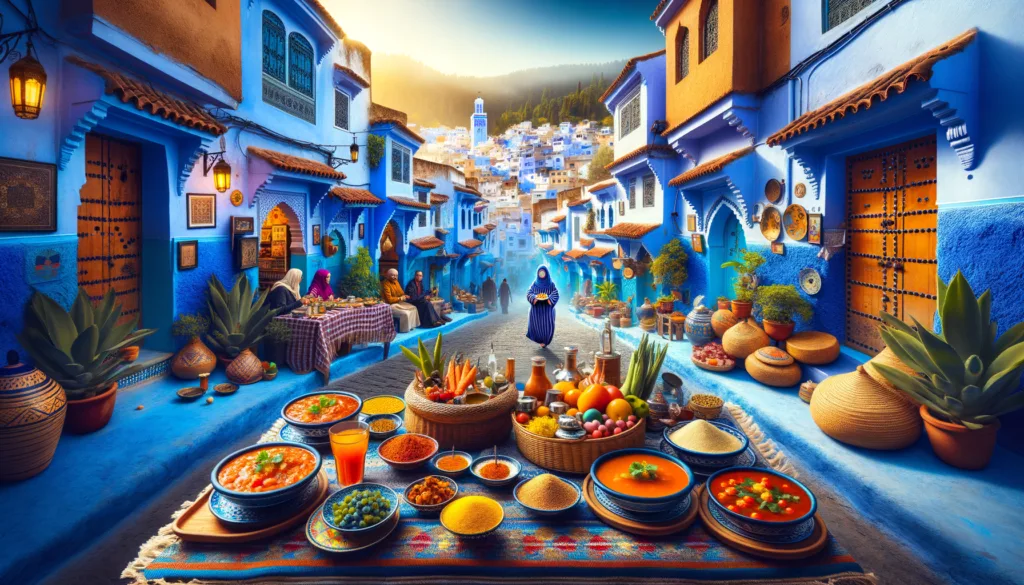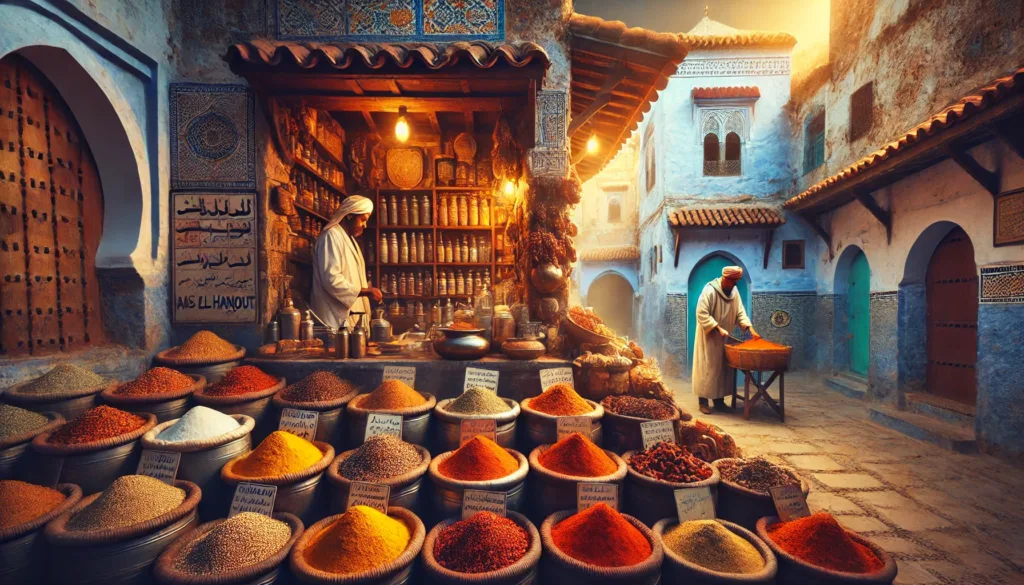
Chefchaouen, fondly known as Morocco’s “Blue Pearl,” is a place that seems almost too magical to be real. Its labyrinth of blue-washed streets transports visitors to a dreamlike world, where every corner feels like a picture-perfect postcard. But Chefchaouen is more than just a visual marvel—it’s a culinary treasure trove that offers food enthusiasts an authentic taste of Moroccan cuisine. Here, time-honored cooking traditions meet bold flavors, filling the air with the scent of spices, fresh herbs, and sizzling tagines.
From the bustling local markets to cozy family-run cafes, Chefchaouen stands as a beacon for gastronomes ready to embark on an unforgettable food odyssey. Prepare to have your cravings ignited and your senses awakened as we dive into the culinary wonders of Morocco’s enchanting Blue City.
Traditional Moroccan Dishes in Chefchaouen
Exploring Local Flavors One Bite at a Time
Tagine
When it comes to Moroccan cuisine, there’s no dish more iconic than the tagine. This slow-cooked masterpiece, prepared in a distinctive cone-shaped clay pot, is a testament to the art of Moroccan cooking. In Chefchaouen, tagines are elevated to new heights with an array of flavor combinations that blend tender meats, seasonal vegetables, sweet dried fruits, and the tantalizing aroma of Ras el Hanout—a spice blend whose name translates to “top of the shop.” Whether it’s lamb with prunes, chicken with preserved lemons and olives, or a vegetarian medley of spiced vegetables, tagine is a must-try dish that’s readily available in eateries across the city.
Couscous
A staple in Moroccan kitchens for centuries, couscous is far more than just a side dish—it’s a cultural tradition. In Chefchaouen, this beloved dish is often prepared and served on Fridays, bringing families together around tables laden with aromatic bowls of steamed semolina topped with hearty meat, root vegetables, and a flavorful broth laced with spices. The layering of textures and tastes in every spoonful of couscous encapsulates Morocco’s culinary philosophy: simple ingredients elevated by love and spices. It’s no surprise that couscous takes center stage in many of the Blue City’s finest meals.
Harira
For those seeking warm, soul-soothing comfort during cooler evenings in Chefchaouen, a steaming bowl of harira fits the bill perfectly. This hearty soup, rich with lentils, chickpeas, tomatoes, and fragrant spices, is synonymous with Moroccan hospitality. Often served with slices of lemon and a side of soft bread, harira is as much a staple on family tables as it is a favorite in humble street-side cafes. It’s a dish that speaks of home, tradition, and the warmth of Moroccan culture—one bowl at a time.
Experiencing Chefchaouen’s Food Scene
Where to Eat and What to Try
Restaurants and Cafes
Chefchaouen offers a vibrant array of dining spots, each showcasing the rich flavors and traditions of Moroccan cuisine. Whether you’re in the mood for a classic tagine or an innovative fusion dish, there’s something for everyone in the Blue City.
Here are some notable spots to check out:
- Bab Ssour: Renowned for its authentic Moroccan dishes in a cozy ambiance, this spot is perfect for savoring classics like lamb tagine or pastilla.
- Morisco: A must-visit for outstanding tagines, succulent lamb dishes, and even unique offerings like tagine breakfasts.
- Cafe Clock: This eclectic eatery blends Moroccan and international flavors seamlessly, offering dishes like camel burgers and hearty Moroccan salads.
Local Markets and Produce
No culinary journey in Chefchaouen is complete without exploring the medina’s lively souks. These bustling markets are a sensory explosion of colors, scents, and sounds, offering fresh produce, fragrant spices, and authentic Moroccan ingredients.
- Sampling Fresh Ingredients: Discover the region’s finest olives, dates, and preserved lemons.
- Mint Tea Tastings: Take a moment to enjoy Morocco’s signature drink—aromatic mint tea—often served with a warm smile and tradition-rich hospitality.
These markets offer more than just food; they provide a cultural immersion through tastes, smells, and interactions with local vendors.
The Cultural and Historical Depth of Moroccan Cuisine

The Story Behind the Spices
Cultural Influences in Chefchaouen
Moroccan cuisine, particularly in Chefchaouen, is a mesmerizing melting pot of influences shaped by centuries of history. From Arab and Berber traditions to Andalusian and European flavors, the city’s culinary scene reflects a crossroads of cultures.
Chefchaouen uniquely combines these diverse elements to create a rich and layered food culture. This historic blend infuses traditional dishes with intriguing spices and techniques passed down through generations, showcasing the city’s deep food heritage.
The Role of Spices
Spices are the heart of Moroccan cuisine, and in Chefchaouen, they tell a story as old as the city itself. Ingredients such as cumin, paprika, cinnamon, turmeric, and saffron bring depth and warmth to dishes. Ras el Hanout, a quintessential Moroccan spice blend, is a shining symbol of the city’s culinary identity.
Exploring the layers of flavor Chefchaouen has to offer is like uncovering a piece of its soul—rich, complex, and incredibly inviting.
Immersive Culinary Experiences
Learn, Cook, Savor
Cooking Classes
If you’re seeking more than just a passive dining experience, Chefchaouen offers a variety of cooking classes that invite you to roll up your sleeves and dive into the heart of Moroccan cuisine. These hands-on culinary workshops teach visitors the traditional techniques behind signature dishes like tagine and couscous, while also introducing them to the secrets of aromatic Moroccan spices.
Participants can learn to mix their own Ras el Hanout, knead dough for fresh breads, and perfect the art of slow-cooking in the iconic tagine pots. Beyond cooking, these sessions often include fascinating insights into the cultural relevance of the ingredients and recipes, turning every moment into a learning adventure.
Food Tours
For a deeper dive into Chefchaouen’s culinary treasures, guided food tours offer an unbeatable way to explore the city one bite at a time. Venture through winding medina streets alongside knowledgeable guides who will introduce you to hidden gastronomic gems, local eateries, and bustling markets.
These tours not only allow you to sample an array of authentic Moroccan flavors, but they also uncover the stories behind the dishes. Whether it’s savoring honey-drenched chebakia or sipping mint tea prepared the time-honored way, every stop unveils a new layer of Chefchaouen’s vibrant food culture.
Conclusion
Chefchaouen isn’t just a feast for the eyes with its stunning blue hues and enchanting streets—it’s also a culinary paradise that tantalizes taste buds and nourishes the soul. From the traditional dishes like tagine, couscous, and harira, to the immersive experiences of cooking classes and guided food tours, every aspect of the city is steeped in flavor, tradition, and history.
For food enthusiasts, Chefchaouen offers more than just a meal—it promises a true journey to the heart of Moroccan culture. Pack your bags, bring your appetite, and prepare to savor every bite. The Blue City is waiting to transform your love of food into an unforgettable adventure.
Frequently Asked Questions About Chefchaouen’s Culinary Scene
What is Chefchaouen famous for in terms of food?
Chefchaouen is renowned for its rich and vibrant culinary scene rooted in traditional Moroccan cuisine. The city is well-known for iconic dishes like tagine, couscous, and harira, as well as its local markets and cafes offering fresh produce and authentic dining experiences.
What are the must-try dishes in Chefchaouen?
Some must-try dishes in Chefchaouen include:
- Tagine: A slow-cooked stew made with meat, vegetables, dried fruits, and Moroccan spices.
- Couscous: Morocco’s national dish, served with vegetables, meat, and flavorful broth.
- Harira: A hearty soup with lentils, chickpeas, tomatoes, and spices.
Are there any recommended restaurants in Chefchaouen?
Yes! Some highly recommended restaurants in Chefchaouen for traditional Moroccan cuisine include:
- Bab Ssour: Known for its authentic tagines and couscous.
- Morisco: Famous for its beef tagine and lamb dishes, along with a unique tagine breakfast.
- Cafe Clock: Perfect for a mix of Moroccan and international dishes.
Where can I experience local culture and buy fresh ingredients in Chefchaouen?
The medina’s local markets (souks) are great places to explore Chefchaouen’s cultural heritage. These markets offer fresh produce, Moroccan spices, and local goods, which allow visitors to experience the city’s traditional food culture firsthand.
Are there any food-related activities for visitors in Chefchaouen?
Yes, visitors in Chefchaouen can join cooking classes or food tours. These activities provide insights into traditional cooking methods, local ingredients, and the preparation of iconic dishes like tagine and couscous, making them ideal for food enthusiasts.
What influences are present in Chefchaouen’s cuisine?
Chefchaouen’s cuisine showcases a blend of cultural influences, including Arab, Berber, and European traditions. These influences are reflected in the city’s diverse range of dishes, cooking methods, and ingredients.